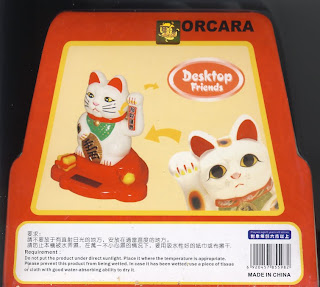Here is the meaning as it is on Wikipedia - http://en.wikipedia.org/wiki/Maneki_Neko :
“The Maneki Neko (招き猫?, literally "Beckoning Cat"; also known as Welcoming Cat, Lucky Cat, Money cat, or Fortune Cat) is a common Asian sculpture, often made of ceramic, which is believed to bring good luck to the owner. The sculpture depicts a cat (traditionally a Japanese Bobtail) beckoning with an upright paw, and is usually displayed—many times at the entrance—in shops, restaurants, pachinko parlors, and other businesses. Some of the sculptures are electric or battery-powered and have a slow-moving paw beckoning. In the design of the sculptures, a raised right paw supposedly attracts money, while a raised left paw attracts customers. Maneki Neko come in different colors, styles, and degrees of ornateness. In addition to sculptures, Maneki Neko can be found as keychains, piggy banks, air fresheners, and miscellaneous ornaments”
But what was more interesting was the writing on the box!
Some very funny examples of Engrish. Here is wikipedia again to explain the term Engrish - http://en.wikipedia.org/wiki/Engrish
“Engrish refers to non-standard variations of English or Spelling used in East Asian countries. While the term may refer to spoken English, it is more often used to describe written English. The term arises from the lack of phonemes corresponding to the English l and r in the spoken Japanese language, which instead has an alveolar flap that roughly corresponds to the English r. Chinese frequently uses the "l" substituted for "r" in foreign loanwords. Engrish is found on a variety of things such as signs, menus, advertisements and t-shirt slogans. Usage of the term ranges from the affectionate to the pejorative. Country-specific terms, such as Japlish or Janglish for Japan, Konglish for Korea, Singlish for Singapore and Chinglish for China also exist.”
Now here is our Neko-Kun and the Engrish instructions and warnings on his box.



No comments:
Post a Comment